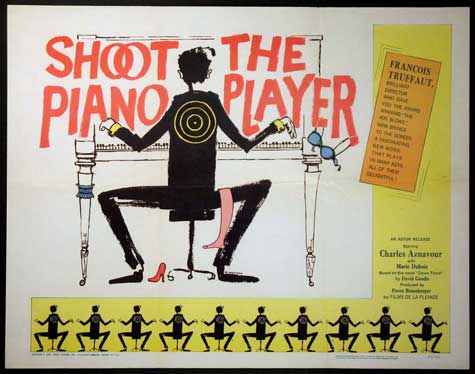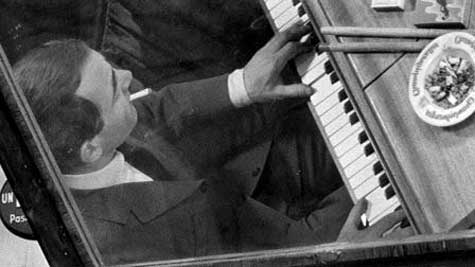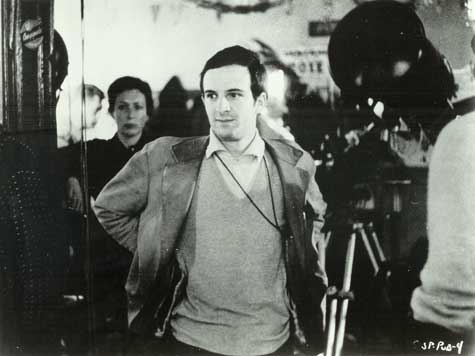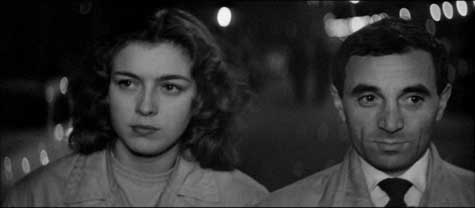
We know about the appreciation of, and contributions to, noir film and fiction by the French. We know that they celebrated the likes of Jim Thompson when the now-revered American noir author was kicked to the curb in his home country. And in 1960 another striking example of U.S. noir being recognized by the French occurred when rising star French film director Francois Truffaut used a novel by American David Goodis as the basis of his second film. Truffaut had come across Goodis’s bleak 1956 title Down There along the way, was enthralled by it, and had one of his legal reps buy the movie rights. Then, after dazzling the movie-watching universe with his groundbreaking debut, 1959’s French New Wave classic The 400 Blows, Truffaut wanted his next film to be something less blatantly French and something that showed the influence American cinema had on him. Cue Shoot the Piano Player and Goodis’s downbeat tale of a once-famous musician, who is now playing tacky fare in a rank-and-file bar, was the perfect vehicle through which the director could put these desires into effect.
Truffaut (who wrote the film script himself, with the aid of Marcel Moussy) pulled some cinematic moves that brought his own vision to the story and he made a significant change in the personality of the main character, but with regards to the basic storyline, he was faithful to Goodis’s novel. The book is set mostly in Philadelphia, and in the movie, it’s Paris, and in the film, the protagonist has a family member not included in the novel. But otherwise, the two stories are the same, and go as such: The primary character’s name is Edward. He goes mostly by Eddie in the novel, and in the movie, he has people call him Charlie, as a means of distancing himself from his past. Since this article is mostly about the movie, we’ll call him Charlie from here on. Charlie (who is played by real life musical performer Charles Aznavour) comes from parents who are neither angels nor devils, just regular folk getting along. But their first two children—Charlie’s older brothers—are hellions, fellas who are just forever ready to make and invite trouble. Charlie is the youngest in the book, but in the film, he has another, much younger, brother. Charlie is not like his elder siblings, being an artistic type who takes up the piano and winds up becoming a concert performer. All is going well in his career, until his piano-playing life and his marriage intersect in a not-good way. Charlie, devastated after that set of events, puts his concert-playing self in a closet and goes slumming, emotionally and in his doings. He winds up tickling the ivories in a rowdy bar, playing rinky-dink tunes for a small wage and to entertain drinking dancers who could care less how well he plays, so long as it’s something to which they can shake their hips.

Charlie has, by this time, also become resolutely detached emotionally. He holds himself aloof from others and sleepwalks through life, playing in the bar and paying his rent and not letting others in. In the movie, he also is in charge of his younger brother, who lives with him in a cheap, rented flat. Two things come along that force Charlie out of his frigid state. The first is when one of his elder brothers shows up at the pub in a wild state. It’s clear that he’s on the run and coming to Charlie for help. It turns out that he and Charlie’s other older brother have been involved in some criminal activities, wherein they gave the shaft to some of their underworld colleagues, who are now after them. In fact, their pursuers are right there in Paris, literally on Charlie’s brother’s heels. Charlie wants nothing to do with any of this, but when the other crooks follow his brother into the bar, he gets pushed into their battle, at that moment and for the foreseeable future. The other thing that occurs to pull Charlie out of his shell is that he develops feelings for a waitress, Lena. She’s a tough, but likable, and pretty young woman who clearly fancies him. When Lena, too, gets into the fray between Charlie’s brothers and their gangster enemies, Charlie is forced to take his fingers off the piano keys and his heart out of the freezer.

Where Truffaut put his own stamp on the tale is mostly via purposeful, directorial trickery. There’s some clear French New Wave effects that were utilized, such as unusual cuts and types of images displayed on the screen. The editing he used in a love scene between Charlie and Lena, where he goes from immediate moments to moments just passed, then back again, over and over, is breathtaking. And the way he employs voice-overs to let us witness the inner struggles in the mind of the indecisive Charlie, is another stroke of cinematic genius and one that gives weight to Charlie’s character and to the story. The respect in which Truffaut altered Charlie’s character is that he made him out to be a man who is timid by nature. In Goodis’s book, the pianist is a guy who never starts his days looking for a scrap, but who can and does knock others around like he’s a prizefighter if they push him. If I have one gripe about Truffaut’s film with respect to the book it came from, it’s that I think the introduction of Charlie’s younger brother was unnecessary; the kid is cute and all, but Charlie’s relationship to him is not really explored and the character doesn’t add much to the story.

One aspect I treasure in the book, and that Truffaut worked to great effect in the film, has to do with the personalities of the two thugs who are after Charlie’s brothers, and their relations to Charlie and Lena. In both the book and movie, the guys are portrayed as bumbling fools, yet completely dangerous men. And they have casual chats with Charlie and his ladyfriend, even when they all know the guys are out to kill Charlie’s siblings and would do the same to Charlie and Lena in a second. This duality makes the two men fully believable, and in a way, even scarier than if they were just coldly calculating professionals.
This article is primarily about Truffaut’s film, so I don’t want to go off on too long a tangent on Goodis’s novel. But in thinking about the story of Charlie/Eddie, it’s interesting to reflect on Goodis’s own life. When his 1946 novel Dark Passage was made into the ’47 Bogart/Bacall film of the same title, Goodis’s writing career appeared to be taking off. He was hired as a Hollywood scriptwriter and moved from his home base of Philadelphia to California, ready to become a big name in the world of the big screen. But by the time Down There was published in ’56, Goodis had been back home in Philly for years, living with his parents and his mentally ill brother. Also, he was known to prowl the seediest corners of the city in the wee hours, and to engage in illicit activities in these quarters. Goodis also had a secret marriage that is no longer a secret and that seems to have left with him permanent psychological damage. So, we’ve got an artist who once seemed at the top of his game and who now is in the gutter, who was wounded by a failed marriage and who appears to have been weighted down by problems involving a troubled sibling. Food for thought.
To be honest, I can’t remember now whether I originally saw Truffaut’s film before reading the Goodis novel, or if it was the other way around. Before writing this piece, I read the book again, then gave the movie a fresh viewing. Goodis is one of my all-time favorite writers, not just of noir but of writing, period; and Down There is one of his very best works IMO. But I wish I could have just watched Shoot the Piano Player in an innocent way, i.e. not knowing anything about the book it came from and not familiar with the storyline. The film is a brilliant piece of work and something that can and should be appreciated on its own, without any reference to the novel from which it originated. For me, it’s a top-tier film noir on a par with the likes of Detour, Gun Crazy, Kansas City Confidential, Out of the Past, Mildred Pierce, etc. Film director Truffaut took a fine novel as his source material and illustrated its gut-wrenching story through his gifted eyes.
Brian Greene's short stories, personal essays, and writings on books, music, and film have appeared in more than 20 different publications since 2008. His articles on crime fiction have also been published by Crime Time, Paperback Parade, Noir Originals, and Mulholland Books. Brian lives in Durham, NC with his wife Abby, their daughters Violet and Melody, their cat Rita Lee, and too many books. Follow Brian on Twitter @brianjoebrain.
See all posts by Brian Greene for Criminal Element.

The combination of Truffaut, Aznavour, and especially David Goodis is enough for me. Another top review, Brian. Thanks.
TOP Cracked Software’s · ProgDVB 7.50.6 Crack with Activation Key Free · VideoPad Video Editor 13.30 Crack with Serial Key Free